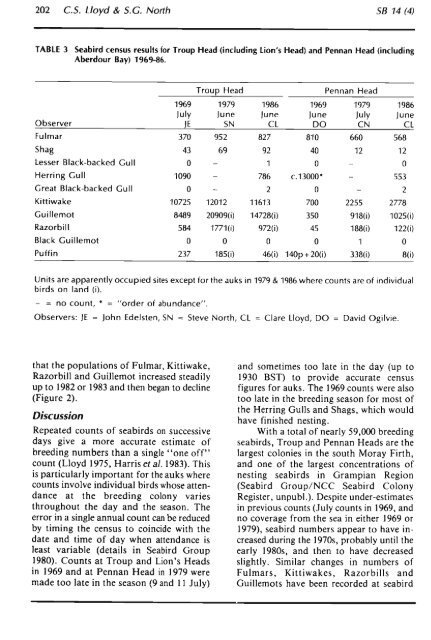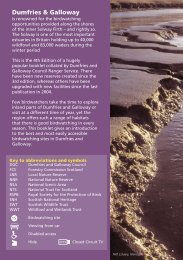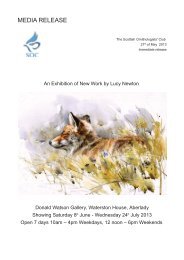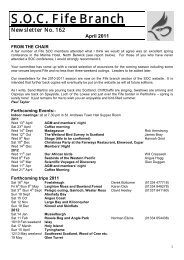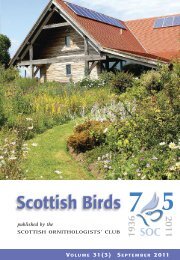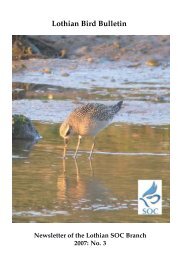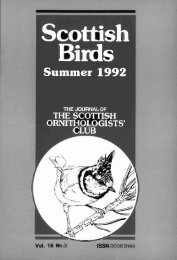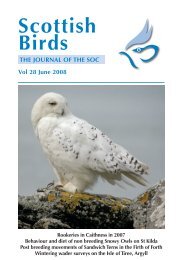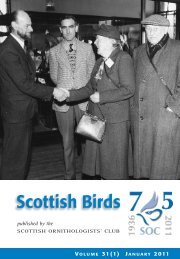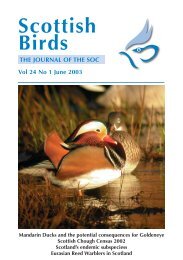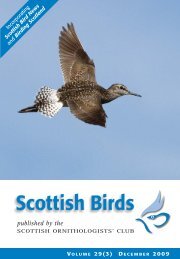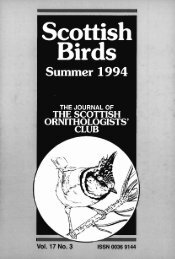V 14 No.4 - The Scottish Ornithologists' Club
V 14 No.4 - The Scottish Ornithologists' Club
V 14 No.4 - The Scottish Ornithologists' Club
You also want an ePaper? Increase the reach of your titles
YUMPU automatically turns print PDFs into web optimized ePapers that Google loves.
202 C.S. Lloyd & S.G. North S8 <strong>14</strong> (4)<br />
TABLE 3 Seabird census results for Troup Head (including Lion's Head) and Pennan Head (including<br />
Aberdour Bay) 1969-86.<br />
Troup Head<br />
Pennan Head<br />
1969 1979 1986 1969 1979 1986<br />
July June June June July June<br />
Observer JE SN CL DO CN CL<br />
Fulmar 370 952 827 810 660 568<br />
Shag 43 69 92 40 12 12<br />
Lesser Black-backed Gull 0 0 0<br />
Herring Gull 1090 786 c.13ooo· 553<br />
Great Black-backed Gull 0 2 0 2<br />
Kittiwake 10725 12012 11613 700 2255 2778<br />
Guillemot 8489 20909(i) <strong>14</strong>728(i) 350 918(i) 1025(i)<br />
Razorbill 584 1771(i) 972(i) 45 188(i) 122(i)<br />
Black Guillemot 0 0 0 0 0<br />
Puffin 237 185(i) 46(i) <strong>14</strong>0p+20(i) 338(i) 8(i)<br />
Units are apparently occupied sites except for the auks in 1979 & 1986 where counts are of individual<br />
birds on land (i).<br />
- = no count, • = " order of abundance".<br />
Observers: JE = John Edelsten, SN = Steve North, CL = Clare Lloyd, DO = David Ogilvie.<br />
that the populations of Fulmar, Kittiwake,<br />
Razorbill and Guillemot increased steadily<br />
up to 1982 or 1983 and then began to decline<br />
(Figure 2).<br />
Discussion<br />
Repeated counts of seabirds on successive<br />
days give a more accurate estimate of<br />
breeding numbers than a single "one off"<br />
count (Lloyd 1975, Harris et al. 1983). This<br />
is particularly important for the auks where<br />
counts involve individual birds whose attendance<br />
at the breeding colony varies<br />
throughout the day and the season. <strong>The</strong><br />
error in a single annual count can be reduced<br />
by timing the census to coincide with the<br />
date and time of day when attendance is<br />
least variable (details in Seabird Group<br />
1980). Counts at Troup and Lion's Heads<br />
in 1969 and at Pennan Head in 1979 were<br />
made too late in the season (9 and 11 July)<br />
and sometimes too late in the day (up to<br />
1930 BST) to provide accurate census<br />
figures for auks. <strong>The</strong> 1969 counts were also<br />
too late in the breeding season for most of<br />
the Herring Gulls and Shags, which would<br />
have finished nesting.<br />
With a total of nearly 59,000 breeding<br />
seabirds, Troup and Pennan Heads are the<br />
largest colonies in the south Moray Firth,<br />
and one of the largest concentrations of<br />
nesting seabirds in Grampian Region<br />
(Seabird Group/NCC Seabird Colony<br />
Register, unpubl.). Despite under-estimates<br />
in previous counts (July counts in 1969, and<br />
no coverage from the sea in either 1969 or<br />
1979), seabird numbers appear to have increased<br />
during the 1970s, probably until the<br />
early 1980s, and then to have decreased<br />
slightly. Similar changes in numbers of<br />
Fulmars, Kittiwakes, Razorbills and<br />
Guillemots have been recorded at seabird


